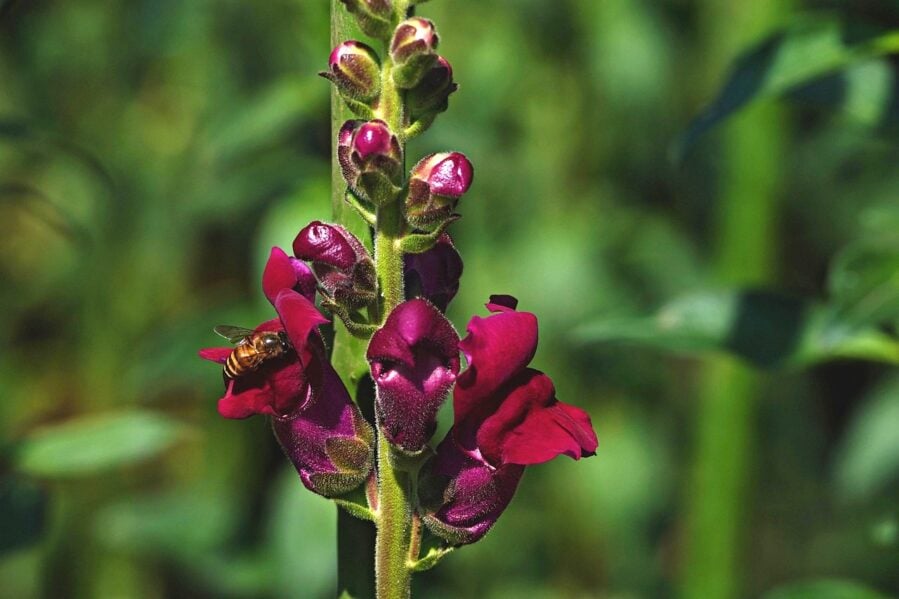Plants may have “ears” after all. New research reveals that flowers can detect the buzzing sounds of approaching pollinators and respond by quickly sweetening their nectar, essentially setting out a better treat for their insect visitors.
This discovery of acoustic communication between plants and pollinators challenges our understanding of plant biology and suggests an intricate relationship millions of years in the making.
The findings, presented Wednesday at the joint meeting of the Acoustical Society of America and International Congress on Acoustics, demonstrate that snapdragon flowers respond to recordings of bee buzzing by increasing sugar content in their nectar and altering gene expression related to sugar production and transport.
Listening for the Right Partner
While scientists have long studied how plants use visual cues and scents to attract pollinators, the acoustic dimension of this relationship has remained largely unexplored until now. The research team, led by Francesca Barbero from the University of Turin, played recordings of buzzing sounds from Rhodanthidium sticticum bees (also known as snail-shell bees) near growing snapdragon flowers.
“Plant-pollinator coevolution has been studied primarily by assessing the production and perception of visual and olfactory cues, even though there is growing evidence that both insects and plants can sense and produce, or transmit, vibroacoustic signals,” said Barbero.
The results were striking. When exposed to the sounds of these efficient pollinators, the snapdragons responded by increasing both the volume and sugar concentration of their nectar. More remarkably, the flowers even changed their gene expression patterns governing sugar transport and nectar production.
This response may represent a sophisticated evolutionary strategy. By enhancing rewards for the right pollinators, plants might increase the time these insects spend visiting their flowers, potentially improving pollination success and reproductive outcomes.
A Two-Way Conversation?
The research raises intriguing questions about whether this acoustic relationship works both ways. Can plants also produce sounds that attract suitable pollinators? The team is currently investigating this possibility.
“The ability to discriminate approaching pollinators based on their distinctive vibroacoustic signals could be an adaptive strategy for plants,” Barbero explained. “By replying to their proper vibroacoustic signal — for instance, an efficient pollinator’s — plants could improve their reproductive success if their responses drive modifications in pollinator behavior.”
If plants can indeed attract pollinators through acoustic means, the implications could extend beyond natural ecosystems. “If this response from insects is confirmed, sounds could be used to treat economically relevant plants and crops, and increase their pollinators’ attraction,” added Barbero.
Beyond Bee Buzzing
Plants appear to detect and respond to various acoustic signals from their environment, not just from pollinators. Previous research has documented plant responses to sound that include:
- Changes in seed germination rates when exposed to certain frequencies
- Physical growth responses to vibration (known as thigmo-morphogenetic responses)
- Increased photosynthetic activity in response to specific sounds
- Modified gene expression and hormone production following acoustic stimulation
- Defensive responses triggered by sounds of herbivore feeding
“The multitude of ways plants can perceive both biotic factors — such as beneficial and harmful insects, other neighboring plants — and abiotic cues, like temperature, drought, and wind in their surroundings, is truly astonishing,” noted Barbero.
The team’s current work expands on these findings by comparing snapdragon responses to different pollinators and even “nectar robbers” – insects that take nectar without pollinating the plant.
A Multidisciplinary Approach
This research brings together specialists from diverse fields, creating a unique collaborative effort to understand these subtle interactions. The project, titled “Good Vibes: How do plants recognise and respond to pollinator vibroacoustic signals?” combines expertise from entomologists, sound engineers, and plant physiologists across three countries.
The international collaboration includes researchers from the University of Turin in Italy, I²SysBio in Valencia, Spain, and the Centre for Audio, Acoustics and Vibration at the University of Technology Sydney, Australia.
As one team member, J. Tomás Matus from I2SysBio in Spain, describes their mission: “We endeavour to revolutionise our understanding of how plants interact with their environment through a finely tuned communication.”
As this research continues to develop, it may fundamentally change how we understand plant communication and perception. The silent world of plants may be less silent than we thought – and the buzz of a bee might be more than just background noise in the garden. It could be part of an ancient acoustic conversation that has been happening all around us, one we’re only now beginning to hear.
If our reporting has informed or inspired you, please consider making a donation. Every contribution, no matter the size, empowers us to continue delivering accurate, engaging, and trustworthy science and medical news. Independent journalism requires time, effort, and resources—your support ensures we can keep uncovering the stories that matter most to you.
Join us in making knowledge accessible and impactful. Thank you for standing with us!

